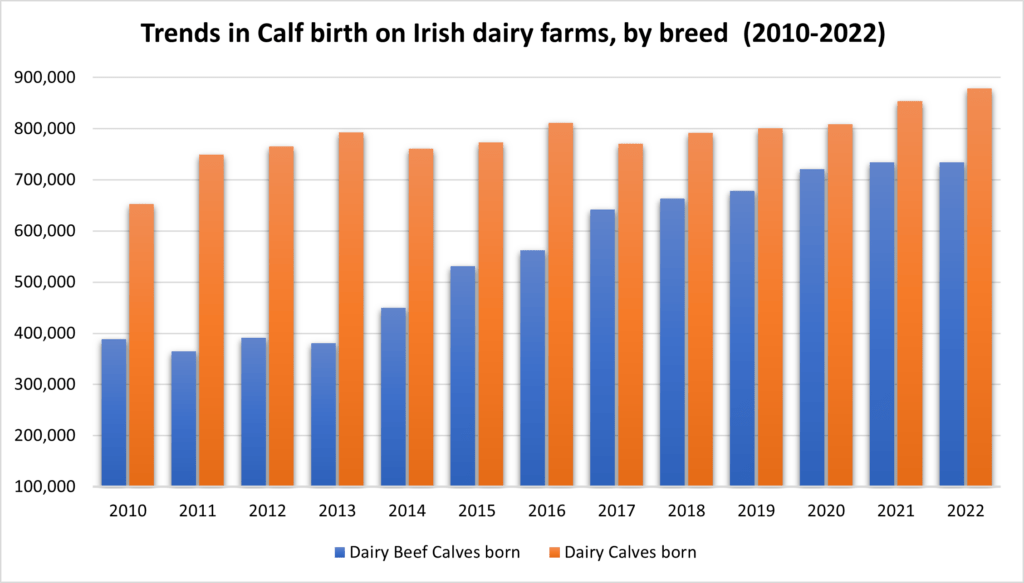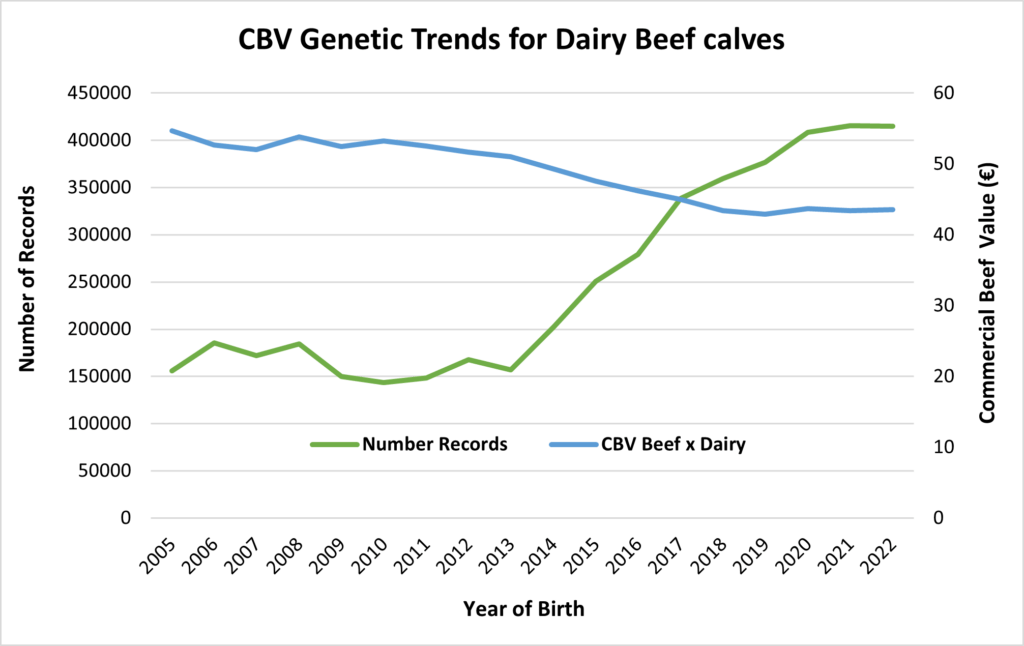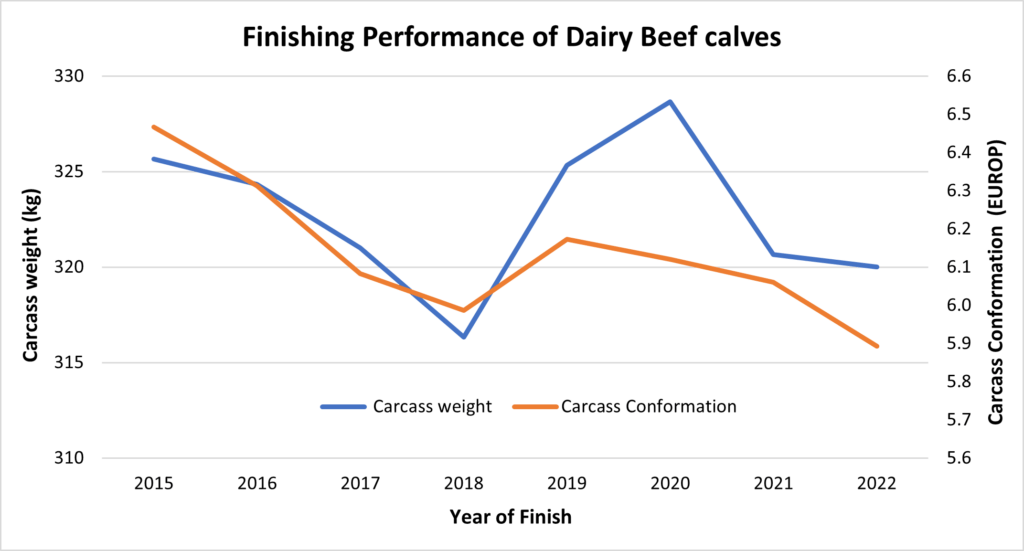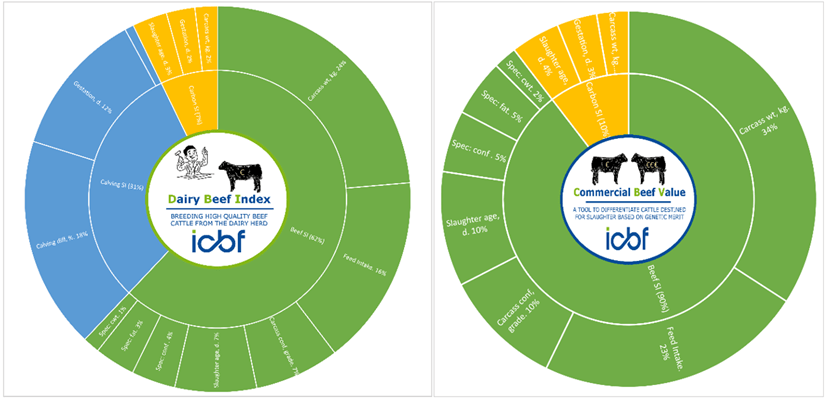Over the past 10 years, dairy cow numbers have increasing significantly. They have increased from 1 million in 2010 to 1.6 million in 2022. This represents an increase of more than 60% of dairy cows in Ireland. The fertility of the national herd has also improved over this period due to increased genetic gain as result from the Economic Breeding Index (EBI). Cows are now more fertile and surviving longer, therefore reducing the number of dairy replacements required in herds. In addition, the usage of sexed semen has increased vastly on dairy farms over the last number of years. Almost 20% of the total AI serves on dairy cows has been to sexed semen All these factors combined have resulted in the increased usage of beef bulls in the dairy herd. This is presented in graph 1 below, which shows the number dairy -beef calves born since 2010. There were 364,570 dairy beef calves born in 2010 compared to 734,688 in 2022. The number of beef births from the dairy cows have doubled and will continue to grow over the next 10 years. There is expected to be around 900,000 dairy beef calves in Ireland by 2032, further increasing the quantity of beef production from dairy herds.

When selecting Beef sires to use on dairy females, dairy farmers primarily select beef bulls that have a short gestation length and are easy calving, without considering the beef carcass merit of the potential progeny. Consequently, the beef genetics of calves from the dairy herd has declined. This is presented on graph 2 below, which shows the Commercial Beef value (CBV) trends of calves born from beef sires and dairy dams since 2005. The CBV genetic trends had been declining from 2010 but has halted since 2019, with the introduction of the dairy beef index. The quality of beef calves coming from the dairy herd has also come under big focus in recent times with increased concerns around future live exports and a ban on the finishing of calves to be implemented in Ireland at the start of next year. Analysis on the fate of calves has shown a significant increase in the number of calves finished (+15.95%) and calves exported (+18.4%) this year.

The Finishing performance in Irish factories for carcass weight and conformation of cattle bred from dairy dams is displayed in graph 3 below. To ensure that there will be beef farmers to rear the increased number of dairy-beef calves in the future, dairy farmers need to focus more on improving the beef merit from the dairy herd. To address the different challenges, there are various tools available to help improve the quality of beef calves coming from the dairy herd.

Dairy Beef Index
The Dairy Beef Index (DBI) is a tool used to identify beef bulls suitable for use on dairy females. The aim of the index is to improve the beef quality of calves produced from the dairy herd that are more saleable as calves and profitable at slaughter without compromising the dairy cow calving performance. The index is comprised of a calving, beef, and carbon sub-index. The relative emphasis of the beef sub index is 62% and this selects for beef traits such as carcass weight and conformation, which are important to the beef farmer. The calving sub index makes up 31% of the index and this selects for calving difficulty, lower mortality, and gestation length, which is important for the dairy farmer. The carbon sub index, which represents 7%, will allow farmers to breed cattle with a lower carbon footprint. The DBI is measured in Euros and for every €1 increase on the DBI is equal to €1 increase in profit for the bull’s progeny. A bull with a high DBI should pass on more desirable characteristics to its progeny than a bull with a low DBI. To maximise carcass merit, select bulls with the highest PTAs for carcass weight and conformation from the dairy beef active bull list. In turn, this will produce a calf that has a high Commercial Beef Value (CBV).
Commercial Beef Value
Commercial Beef Value is a tool to help identify animals with higher potential for beef production from the dairy herd.The CBV is the genetic value for animals destined to be finished for beef based on its parentage. The index comprised of a beef and carbon sub index, which is displayed in graph 3 and includes key traits such as carcass weight, carcass conformation, carcass fat, feed intake, age at slaughter and docility. The CBV is expressed in Euros, which reflects the expected profit at point of finish and is available for non-breeding animals such as dairy males and calves sired by a beef bull. Animals with a higher CBV value will be on average faster growing, grade better at finish, meet market specification at a younger age and have a higher carcass value compared to animals that have low commercial beef value. Therefore, these animals are more profitable and knowing this genetic information will help make farmers more informed selling and purchasing decisions. For a CBV to be generated for a calf, they must have a sire recorded. The CBV is available through the profile section of the ICBF HerdPlus account. This will be available in marts also for animals with a genotype to guarantee correct parentage.

Summary
Utilising tools such as the as the dairy beef-index DBI and the Commercial Beef Value (CBV) will improve the beef merit from the dairy herd. This will ensure that more dairy-bred beef calves will meet minimum factory specifications. Also, Improving the beef traits of calves from the dairy herd will enhance the integration between the dairy and beef systems, which will be an important tool in supporting the economic and environmental of both sectors. The sire advice tool will generate the best and balanced dairy beef mating in terms of beef value of the progeny produced while not causing any increased calving difficulty for the dairy farmer. A new dairy beef Scorecard report developed by the DAFM-led Calf Stakeholder Forum will also be available for dairy farmers in the coming weeks. The aim of this report is to make herd-owners aware of the Key Performance Indicators that contribute to greater dairy beef integration. The scorecard will allow farmers to evaluate their own herd’s dairy beef integration performance.
